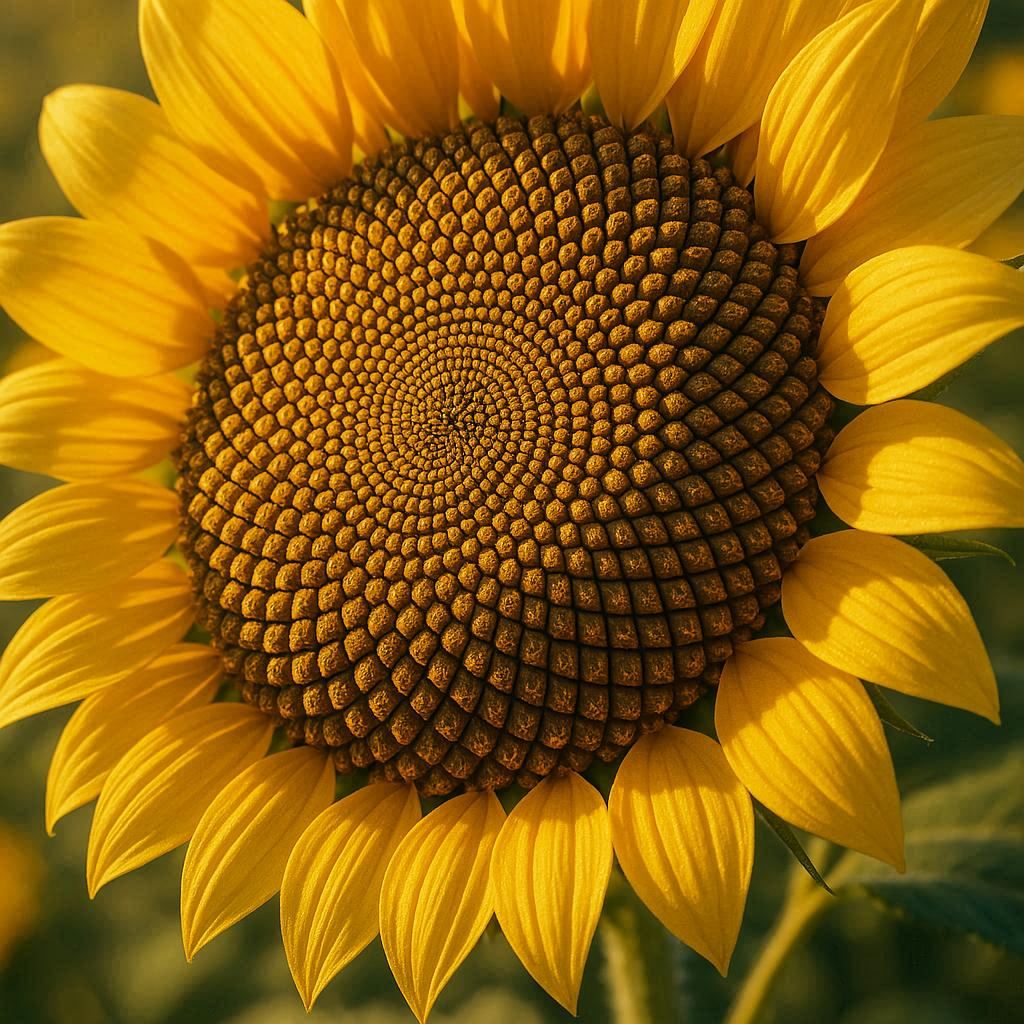There is a number that has fascinated mathematicians, artists, philosophers, and scientists for centuries. It appears in the spirals of galaxies and the petals of flowers, in seashells and hurricanes, in the design of ancient temples and even in the proportions of the human body. This mysterious number is known as the Golden Ratio, often represented by the Greek letter phi (φ), approximately equal to 1.6180339887…
At first glance, the Golden Ratio seems like a simple mathematical curiosity, just another number among countless others. But a deeper look reveals that it is woven into the very fabric of the universe. Nature itself seems to prefer this ratio when building forms, arranging patterns, and shaping growth. This uncanny recurrence raises profound questions: why does nature favor this number? Is it merely coincidence, or does the Golden Ratio reveal a deeper mathematical principle underlying reality itself?
To explore this mystery, we must journey through mathematics, biology, art, and cosmology—uncovering the ways in which this single number connects the smallest leaf to the grandest galaxy.
The Birth of a Golden Idea
The origins of the Golden Ratio trace back to ancient mathematics. The earliest references appear in the works of Euclid around 300 BCE. In his legendary text Elements, Euclid described a way of dividing a line into two unequal parts such that the ratio of the whole to the larger part is the same as the ratio of the larger part to the smaller. This division, he wrote, produced what he called the “extreme and mean ratio.” Later, it came to be known as the Golden Ratio.
Mathematically, the Golden Ratio can be expressed as a simple equation:
If a line is divided into a longer part (a) and a shorter part (b), then (a + b)/a = a/b = φ.
This self-replicating property is what makes the ratio so unique. It is not just a number; it is a proportion that seems to repeat itself endlessly, appearing in different scales and contexts, much like a fractal echo through nature and art.
The fascination with this ratio did not remain confined to mathematics. Ancient architects, particularly in Greece and later in Rome, incorporated it into the design of temples and monuments. The Parthenon in Athens, with its harmonious proportions, is often said to embody the Golden Ratio. Renaissance masters such as Leonardo da Vinci drew upon it in art and anatomy, believing it to represent the ideal of beauty and balance.
But long before humans began to consciously use it, nature had already been quietly building with it.
Spirals in Shells and Seeds
One of the most striking appearances of the Golden Ratio is in spirals found throughout the natural world. Seashells, pinecones, sunflowers, and even hurricanes often exhibit spirals that expand according to proportions close to φ.
Consider the humble sunflower. Its central disk is filled with seeds arranged in spirals radiating outward. If you count the spirals twisting clockwise and those twisting counterclockwise, you will often find numbers like 34 and 55, or 55 and 89—successive numbers in the Fibonacci sequence. This sequence, discovered by Leonardo of Pisa (known as Fibonacci) in the 13th century, begins 1, 1, 2, 3, 5, 8, 13, 21, and so forth, with each number being the sum of the previous two. The fascinating link is that as the sequence progresses, the ratio between successive numbers approaches the Golden Ratio.
The sunflower, without any knowledge of mathematics, arranges its seeds in a way that optimizes packing efficiency. The Golden Ratio allows seeds to be evenly distributed without overlapping, ensuring maximum space and exposure to sunlight. What appears as mere beauty is, in fact, nature’s solution to a problem of efficiency.
Seashells, too, grow in spirals that expand logarithmically, often approximating the Golden Ratio. The chambered nautilus, with its mesmerizing spiral shell, is an iconic example. Each new chamber is proportionally larger than the last, maintaining a consistent ratio as the animal grows. This ensures stability and balance, a functional architecture encoded in mathematics.
The Fibonacci Connection
The Golden Ratio and the Fibonacci sequence are deeply intertwined, and this connection provides insight into why nature favors this pattern.
The ratio between successive Fibonacci numbers—say, 34/21 or 89/55—approaches φ as the sequence grows. This convergence links a simple additive process to one of the most profound proportions in mathematics. Nature seems to “compute” growth by using such additive patterns.
Leaves on a stem often follow this spiral arrangement, called phyllotaxis, which allows them to maximize light capture without shading one another. The number of spirals in pinecones, artichokes, and pineapples also frequently correspond to Fibonacci numbers. What seems at first like a coincidence turns out to be a recurring solution to problems of packing, growth, and efficiency.
Thus, the Golden Ratio is not just an abstract number but a blueprint for survival. Plants and organisms that follow these patterns gain evolutionary advantages. They capture more light, grow more efficiently, and distribute seeds more effectively. The beauty we admire in a sunflower or a shell is, in essence, the beauty of nature solving problems through mathematics.
The Human Face and Body
The Golden Ratio is often associated with beauty in human proportions. Though popular culture sometimes exaggerates its role, scientific studies suggest there is indeed a subtle link between φ and human aesthetics.
The human face, when analyzed through geometry, often displays proportions close to the Golden Ratio. The distance between the eyes, the length of the nose compared to the width of the mouth, and even the overall shape of the face tend to align, at least approximately, with φ. The same applies to the human body: the ratio of the forearm to the hand, or the navel’s position along the torso, often reflects Golden Ratio proportions.
Renaissance artists like Leonardo da Vinci and architects like Le Corbusier consciously used these ratios in their work, believing they reflected universal beauty and harmony. In Leonardo’s Vitruvian Man, a study of human proportions, the Golden Ratio is woven into the geometry of the body.
While not every beautiful face or body adheres strictly to φ, our perception of balance and harmony seems to be influenced by it. This suggests that the Golden Ratio might be embedded not only in physical forms but also in how our brains perceive beauty. Evolutionarily, symmetry and proportion are associated with health and vitality, which may explain why we find such ratios pleasing.
The Golden Ratio in Art and Architecture
For centuries, artists and architects have turned to the Golden Ratio as a guide to composition and design. From the pyramids of Egypt to the Gothic cathedrals of Europe, from Renaissance paintings to modern architecture, the ratio has been invoked to create structures that feel balanced, harmonious, and aesthetically timeless.
In painting, the Golden Ratio has been used to structure canvases, divide spaces, and guide the placement of subjects. Leonardo da Vinci’s works, including the Mona Lisa and The Last Supper, are often said to reflect these proportions. In architecture, buildings like the Parthenon or the Notre Dame Cathedral demonstrate the harmony of φ in their facades and layouts.
The power of the Golden Ratio in art lies in its ability to create balance without rigidity. Too much symmetry can feel mechanical, while too little feels chaotic. The Golden Ratio offers a middle path, balancing order with organic flow, much like nature itself. It resonates with viewers not because of mathematical precision alone but because it mirrors patterns our minds instinctively recognize.
Cosmic Spirals and Galactic Beauty
The reach of the Golden Ratio extends far beyond Earth. Astronomers have found that spiral galaxies, including our own Milky Way, often exhibit arms that spread in spirals close to φ proportions. Hurricanes on Earth, governed by the same physical principles, also form spirals reminiscent of the Golden Ratio.
Even planetary orbits and orbital resonances echo Fibonacci ratios. Jupiter’s moons, for example, fall into orbital patterns that approximate these sequences. The same laws of mathematics that govern seeds in a sunflower appear to govern the motion of celestial bodies across the cosmos.
This cosmic recurrence deepens the mystery. Is the Golden Ratio merely a byproduct of physical laws—an efficient way for systems to arrange themselves—or is it something more fundamental, a clue to the underlying design of the universe?
The Mathematics of Efficiency
Why does nature favor the Golden Ratio? The answer lies in efficiency and balance. The ratio provides solutions to problems of growth, distribution, and stability. Spirals expanding according to φ avoid overlap and allow optimal packing. Proportions based on φ distribute forces evenly, providing structural stability in shells, horns, and even bones.
Mathematically, the Golden Ratio is also related to self-similarity, a property of fractals. A shape divided according to φ retains the same proportions as the original. This recursive property mirrors the way nature often builds—from branching trees to blood vessels, from river networks to lightning bolts. The Golden Ratio offers a template for growth that is simple yet infinitely adaptable.
In essence, the Golden Ratio represents balance between competing demands: order and variation, symmetry and asymmetry, growth and stability. It is not a rigid law but a tendency, a mathematical solution that nature arrives at again and again.
Beyond Mathematics: The Philosophy of φ
The Golden Ratio is not only a mathematical and natural phenomenon but also a philosophical symbol. To many thinkers, it represents the bridge between the finite and the infinite, the material and the ideal. Its endless recurrence in nature suggests a hidden order beneath apparent chaos.
Philosophers of antiquity saw in it a reflection of cosmic harmony. Renaissance humanists embraced it as a key to understanding divine proportion. In modern times, scientists and philosophers alike ponder whether φ is simply an emergent property of natural laws or evidence of deeper mathematical structure in the universe.
The fascination endures because the Golden Ratio embodies both mystery and clarity. It is precise, calculable, and yet endlessly elusive in its manifestations. It invites us to wonder whether mathematics is merely a human invention or a language inscribed in the cosmos itself.
A Number That Unites Science and Beauty
What makes the Golden Ratio so compelling is its dual nature. It is a tool of mathematics, yet it touches art, biology, physics, and philosophy. It explains the spirals of galaxies, yet it also shapes the strokes of a painter’s brush. It enhances survival in plants, yet it also defines beauty in human faces.
This unity across domains suggests that the Golden Ratio is more than coincidence. It is a reminder that the divisions we create between science and art, mathematics and beauty, are artificial. At the deepest level, the same patterns govern both the growth of a flower and the architecture of a cathedral.
Albert Einstein once remarked that “the most incomprehensible thing about the universe is that it is comprehensible.” The Golden Ratio is a shining example of this paradox. A simple number, derived from dividing a line, resonates across galaxies, seashells, and masterpieces of art. It is as though nature, in building itself, has chosen a language of balance and harmony that we too can understand.
The Eternal Spiral
The story of the Golden Ratio is far from finished. Scientists continue to explore its role in physics, biology, and cosmology. Artists and designers continue to draw upon its proportions, knowingly or unconsciously, to create works that feel timeless. Philosophers and dreamers continue to wonder at its deeper meaning.
The Golden Ratio remains a mystery not because we lack equations to describe it but because it awakens something beyond equations—a sense of wonder at the hidden unity of the world. It whispers that beauty and order are not human inventions but reflections of universal principles.
Next time you look at a sunflower, a seashell, or the spiral arms of the Milky Way, pause and consider that what you see is not just chance but the echo of a number, a proportion that nature has chosen again and again. The Golden Ratio is not simply mathematics; it is the poetry of the universe written in numbers. It is the pattern that reminds us we are part of a cosmos at once logical and beautiful, ordered and mysterious.
Conclusion: Why Nature Favors This Pattern
The Golden Ratio endures because it is not confined to one domain but woven into all. Nature favors it because it solves problems of growth, distribution, and balance. It appears in art and architecture because our minds, shaped by the same natural principles, resonate with its harmony. It recurs in the cosmos because the same mathematics governs the spiral of a galaxy as the unfolding of a fern.
Ultimately, the Golden Ratio is more than a number. It is a key to understanding why the universe is not just functional but beautiful. It reveals that efficiency and elegance, survival and symmetry, are not opposites but partners in the dance of existence.
The Golden Ratio is nature’s way of saying that mathematics is not cold abstraction but living truth. It is the silent architect behind petals and stars, the invisible rhythm of life and cosmos. It is the number that unites science and art, reminding us that the world is not only comprehensible but wondrous beyond measure.






